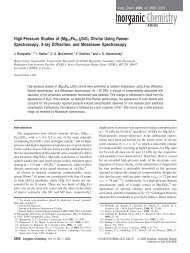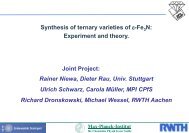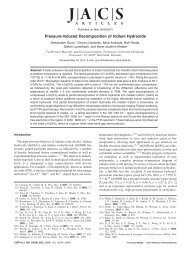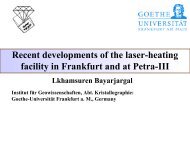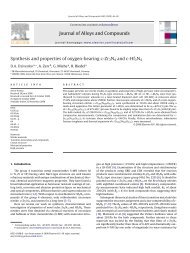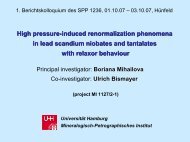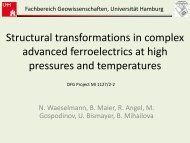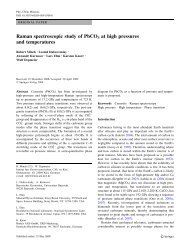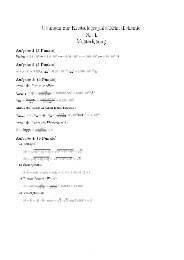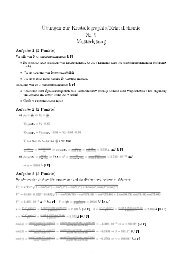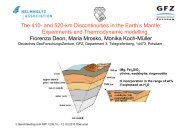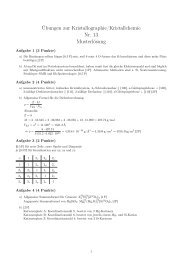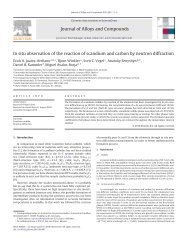High (pressure, temperature) phase diagrams of ZnO and AlN from ...
High (pressure, temperature) phase diagrams of ZnO and AlN from ...
High (pressure, temperature) phase diagrams of ZnO and AlN from ...
Create successful ePaper yourself
Turn your PDF publications into a flip-book with our unique Google optimized e-Paper software.
<strong>High</strong> (<strong>pressure</strong>, <strong>temperature</strong>) <strong>phase</strong> <strong>diagrams</strong> <strong>of</strong> <strong>ZnO</strong> <strong>and</strong> <strong>AlN</strong> <strong>from</strong><br />
second harmonic generation measurements<br />
Lkhamsuren Bayarjargal <strong>and</strong> Björn Winkler<br />
Citation: Appl. Phys. Lett. 100, 021909 (2012); doi: 10.1063/1.3676057<br />
View online: http://dx.doi.org/10.1063/1.3676057<br />
View Table <strong>of</strong> Contents: http://apl.aip.org/resource/1/APPLAB/v100/i2<br />
Published by the American Institute <strong>of</strong> Physics.<br />
Related Articles<br />
Clusters in a mixture <strong>of</strong> an “amphiphilic” ionic liquid <strong>and</strong> a nonionic liquid: Theoretical study<br />
JCP: BioChem. Phys. 6, 01B601 (2012)<br />
Clusters in a mixture <strong>of</strong> an “amphiphilic” ionic liquid <strong>and</strong> a nonionic liquid: Theoretical study<br />
J. Chem. Phys. 136, 014504 (2012)<br />
Insulator-metal transition in GeTe/Sb2Te3 multilayer induced by grain growth <strong>and</strong> interface barrier<br />
Appl. Phys. Lett. 99, 212105 (2011)<br />
A simple model for nan<strong>of</strong>iber formation by rotary jet-spinning<br />
Appl. Phys. Lett. 99, 203107 (2011)<br />
Phase diagram <strong>of</strong> the uniaxial <strong>and</strong> biaxial s<strong>of</strong>t–core Gay–Berne model<br />
J. Chem. Phys. 135, 134119 (2011)<br />
Additional information on Appl. Phys. Lett.<br />
Journal Homepage: http://apl.aip.org/<br />
Journal Information: http://apl.aip.org/about/about_the_journal<br />
Top downloads: http://apl.aip.org/features/most_downloaded<br />
Information for Authors: http://apl.aip.org/authors<br />
Downloaded 11 Jan 2012 to 141.2.229.41. Redistribution subject to AIP license or copyright; see http://apl.aip.org/about/rights_<strong>and</strong>_permissions
<strong>High</strong> (<strong>pressure</strong>, <strong>temperature</strong>) <strong>phase</strong> <strong>diagrams</strong> <strong>of</strong> <strong>ZnO</strong> <strong>and</strong> <strong>AlN</strong> <strong>from</strong> second<br />
harmonic generation measurements<br />
Lkhamsuren Bayarjargal a) <strong>and</strong> Björn Winkler<br />
Institut für Geowissenschaften, Goethe-Universität, Altenhöferallee 1, D-60438 Frankfurt a. M., Germany<br />
(Received 3 November 2011; accepted 20 December 2011; published online 11 January 2012)<br />
The <strong>pressure</strong>-induced B4 ! B1 structural <strong>phase</strong> boundaries <strong>of</strong> <strong>ZnO</strong> <strong>and</strong> <strong>AlN</strong> have been determined<br />
with the second harmonic generation (SHG) technique at high <strong>temperature</strong>. The SHG<br />
measurements <strong>of</strong> <strong>AlN</strong> show that between 15.6 <strong>and</strong> 18 GPa, the <strong>phase</strong> boundary has a negative slope<br />
<strong>of</strong> nearly 627 K/GPa, <strong>and</strong> that below 15.6 GPa, the slope is significantly smaller ( 77 K/GPa).<br />
<strong>ZnO</strong> has a <strong>phase</strong> boundary with a negative slope <strong>of</strong> nearly 1427 K/GPa around 5.3–6 GPa <strong>and</strong><br />
228 K/GPa below 5 GPa. The <strong>phase</strong> transition <strong>pressure</strong> <strong>of</strong> <strong>AlN</strong> is sensitive to deviatoric stress <strong>and</strong><br />
varies <strong>from</strong> 18 to 24.5 GPa. VC 2012 American Institute <strong>of</strong> Physics. [doi:10.1063/1.3676057]<br />
Laser heating experiments in a diamond anvil cell<br />
(DAC) allow to study materials under extreme conditions,<br />
but in situ measurements to delineate <strong>phase</strong> boundaries are<br />
still challenging. Typical in situ characterization methods for<br />
DAC are x-ray diffraction, inelastic x-ray scattering, x-ray<br />
absorption spectroscopy, Mössbauer, <strong>and</strong> various optical<br />
spectroscopic methods (Raman, IR, <strong>and</strong> UV). In contrast to<br />
diffraction <strong>and</strong> these spectroscopic techniques, second harmonic<br />
generation (SHG) has been used rather seldom for<br />
high <strong>pressure</strong> experiments. 1–3 At ambient conditions, SHG<br />
has been established as a versatile probe <strong>of</strong> crystallographic<br />
symmetry. 4 In particular, SHG powder measurements are<br />
extremely sensitive to detect the absence <strong>of</strong> an inversion center<br />
in crystalline structures 5 <strong>and</strong> <strong>phase</strong> transitions at high<br />
<strong>temperature</strong>. 6 In a pioneering high (<strong>pressure</strong>, <strong>temperature</strong>)<br />
study, the presence <strong>of</strong> SHG was used to confirm the absence<br />
<strong>of</strong> a center <strong>of</strong> symmetry in a high <strong>pressure</strong> <strong>and</strong> high <strong>temperature</strong><br />
<strong>phase</strong> <strong>of</strong> CO 2, 7 but systematic studies have been presented<br />
only at high <strong>pressure</strong> for quartz, 1 ZnSe, 2 <strong>and</strong> <strong>ZnO</strong>. 3<br />
However, the SHG method has not been used for delineation<br />
<strong>of</strong> <strong>phase</strong> boundaries at high (p,T).<br />
<strong>AlN</strong> <strong>and</strong> <strong>ZnO</strong> are isostructural to wurtzite at ambient<br />
conditions, i.e., the hexagonal, acentric B4 structure type. At<br />
ambient <strong>temperature</strong> <strong>and</strong> high <strong>pressure</strong>, the B4 <strong>phase</strong> transforms<br />
into the rocksalt structure (B1). 8–14 The wurtzite-torocksalt<br />
structural <strong>phase</strong> boundary <strong>of</strong> <strong>AlN</strong> was studied<br />
through ab initio calculations 15 <strong>and</strong> by multi anvil press<br />
experiments. 16 However, the five experimental data points<br />
obtained earlier in a very limited (p,T) range 16 are insufficient<br />
to delineate the <strong>phase</strong> boundary <strong>of</strong> <strong>AlN</strong> at high (p,T).<br />
No further experimental studies <strong>of</strong> the <strong>phase</strong> boundary <strong>of</strong><br />
<strong>AlN</strong> have been reported so far at high (p,T).<br />
The <strong>phase</strong> boundary <strong>of</strong> the B4 ! B1 transition <strong>of</strong> <strong>ZnO</strong><br />
has a slope with dP/dT 0 up to 1273 K, 10 while earlier a<br />
negative slope dP/dT ¼ 5 10 3 GPa/K <strong>of</strong> the <strong>phase</strong><br />
boundary had been reported <strong>from</strong> 600 to 1000 K. 10 Based on<br />
atomistic simulations, the melting <strong>temperature</strong> increases<br />
<strong>from</strong> 2400 to 3400 K with increasing <strong>pressure</strong>. 17 Hence,<br />
there is a large region in (p,T) space where the position <strong>of</strong><br />
the <strong>phase</strong> boundary is unknown. SHG experiments on <strong>AlN</strong><br />
<strong>and</strong> <strong>ZnO</strong> benefit <strong>from</strong> the very large SHG coefficients (11.7<br />
a) Electronic mail: Bayarjargal@kristall.uni-frankfurt.de.<br />
APPLIED PHYSICS LETTERS 100, 021909 (2012)<br />
<strong>and</strong> 5.6 pm/V for <strong>AlN</strong> <strong>and</strong> <strong>ZnO</strong>, respectively) which are<br />
20–40 times larger than quartz, 18 <strong>and</strong> here, we show that the<br />
(p,T) <strong>phase</strong> diagram <strong>of</strong> these systems can efficiently be studied<br />
by SHG measurements. The onset <strong>of</strong> the <strong>phase</strong> transition<br />
causes a decrease <strong>of</strong> the SHG signal, <strong>and</strong> the transition is<br />
complete once the SHG signal has vanished.<br />
For our experiment, we used compacted powder samples<br />
<strong>of</strong> <strong>ZnO</strong> (99% purity, Merck) <strong>and</strong> <strong>AlN</strong> (99% purity, Strem).<br />
The samples were loaded into holes <strong>of</strong> 110–140 lm diameter<br />
in tungsten gaskets preindented to thicknesses <strong>of</strong> 38–46 lm<br />
in Boehler-Almax diamond anvil cells. 19 KCl <strong>and</strong> Ne were<br />
used as a <strong>pressure</strong> medium for laser heating experiments,<br />
<strong>and</strong> KCl was used also to thermally insulate the sample <strong>from</strong><br />
the diamond. Pressure was determined using the ruby fluorescence<br />
method. For the <strong>pressure</strong> measurements, a blue<br />
laser (k ¼ 473 nm, 80 mW power) is employed. The accuracy<br />
<strong>of</strong> the <strong>pressure</strong> measurements is better than 0.2 GPa. The<br />
<strong>pressure</strong> range <strong>of</strong> laser heating experiments was defined by<br />
the <strong>pressure</strong> before <strong>and</strong> after laser heating. A CO2 laser<br />
(Coherent, Diamond K-250, TEM00) was employed for heating<br />
the sample. The laser heating part <strong>of</strong> our experimental<br />
set-up is described in detail in Ref. 20. The <strong>temperature</strong>s <strong>of</strong><br />
the heated area are determined by the two-colour pyrometer<br />
method, Planck <strong>and</strong> Wien fit. The accuracy <strong>of</strong> <strong>temperature</strong><br />
measurement is around 6150 K. For the in-situ SHG measurements,<br />
a pulsed Nd:YAG laser (Continuum, Surelite,<br />
k ¼ 1064 nm, 10 Hz, 6 ns) was integrated into the CO 2 laser<br />
heating system. With a harmonic separator <strong>and</strong> with a monochromator,<br />
the fundamental infrared light was separated<br />
<strong>from</strong> the generated second harmonic. The generated SHG<br />
signal was collected with a photo-multiplier (R2949, Hamamatsu)<br />
<strong>and</strong> oscilloscope. In the annealing experiments, the<br />
<strong>pressure</strong> was increased up to an initial <strong>pressure</strong> without heating.<br />
At that <strong>pressure</strong>, we heated the sample up to the defined<br />
<strong>temperature</strong>. Then the sample was quenched to ambient <strong>temperature</strong>.<br />
The SHG signal <strong>of</strong> the heated samples was collected<br />
with an experimental setup which has been described<br />
in detail elsewhere. 3<br />
The <strong>pressure</strong> dependence <strong>of</strong> the SHG intensity <strong>of</strong> <strong>AlN</strong><br />
was studied up to a <strong>pressure</strong> <strong>of</strong> 35 GPa at ambient <strong>temperature</strong><br />
in different <strong>pressure</strong> media. The evolution <strong>of</strong> the SHG<br />
intensity with increasing <strong>pressure</strong> is shown in Fig. 1.<br />
On increasing <strong>pressure</strong>, the SHG intensity <strong>of</strong> <strong>AlN</strong> increases<br />
0003-6951/2012/100(2)/021909/3/$30.00 100, 021909-1<br />
VC 2012 American Institute <strong>of</strong> Physics<br />
Downloaded 11 Jan 2012 to 141.2.229.41. Redistribution subject to AIP license or copyright; see http://apl.aip.org/about/rights_<strong>and</strong>_permissions
021909-2 L. Bayarjargal <strong>and</strong> B. Winkler Appl. Phys. Lett. 100, 021909 (2012)<br />
SHG intensity [arb. units]<br />
SHG intensity [arb. units]<br />
100<br />
80<br />
60<br />
40<br />
20<br />
0<br />
0 5 10 15 20 25 30<br />
Pressure [GPa]<br />
120<br />
100<br />
80<br />
60<br />
40<br />
20<br />
0<br />
0 5 10 15 20 25 30 35<br />
Pressure [GPa]<br />
up to 16 GPa in a nonhydrostatic <strong>pressure</strong> medium (KCl) <strong>and</strong><br />
drops to zero at around 26 GPa. At 16 GPa, the B4 <strong>phase</strong><br />
starts to transform into the B1 <strong>phase</strong>. In the nonhydrostatic<br />
<strong>pressure</strong> medium, both <strong>phase</strong>s coexist between 16 <strong>and</strong><br />
26 GPa, presumably, as the transition is kinetically hindered.<br />
In contrast, the <strong>phase</strong> transition <strong>of</strong> <strong>AlN</strong> measured in a quasihydrostatic<br />
<strong>pressure</strong> medium (Ne) shows an increase <strong>of</strong> the<br />
SHG intensity up to 22.5 GPa <strong>and</strong> drops up to 27.5 GPa. The<br />
<strong>pressure</strong> range <strong>from</strong> the onset to the completion <strong>of</strong> the <strong>phase</strong><br />
transition is around 5 GPa, twice smaller than the <strong>pressure</strong><br />
range observed in KCl. The coexistence range or the transition<br />
rate probably depends on the rate with which <strong>pressure</strong> is<br />
increased but this was not studied here. The transition <strong>pressure</strong>s<br />
24.5 GPa <strong>and</strong> 18 GPa were taken as the <strong>pressure</strong> where<br />
the SHG intensity had decreased by 50% in nonhydrostatic<br />
<strong>and</strong> quasihydrostatic <strong>pressure</strong> medium, respectively. These<br />
observations can explain the discrepancies reported in the literature<br />
concerning the <strong>phase</strong> transition <strong>pressure</strong> (22.9 GPa<br />
<strong>and</strong> 14-20 GPa <strong>from</strong> x-ray diffraction, 13,14 16.9 GPa <strong>from</strong><br />
visual observation, 21<br />
B4 B1<br />
(a) <strong>AlN</strong> in KCl<br />
(b) <strong>AlN</strong> in Ne<br />
B4 B1<br />
FIG. 1. Pressure dependence <strong>of</strong> the SHG intensity on <strong>pressure</strong> increase. The<br />
two graphs show the experiments in two different <strong>pressure</strong> media KCl (a)<br />
<strong>and</strong> Ne (b). The vertical dashed gray line presents the <strong>pressure</strong> chosen as the<br />
transition <strong>pressure</strong> <strong>of</strong> the B4 ! B1 <strong>phase</strong> transition. The dashed dark line<br />
represents a fit <strong>of</strong> the <strong>pressure</strong> dependence <strong>of</strong> the SHG signal.<br />
<strong>and</strong> 22 GPa <strong>from</strong> shock wave<br />
experiments 22 ).<br />
Figure 2 shows the <strong>phase</strong> diagram for <strong>AlN</strong> based upon<br />
the measurements described here, five data points <strong>from</strong> an<br />
earlier experimental study 16 <strong>and</strong> a previous theoretical<br />
study. 15 In our experiments, the <strong>phase</strong> boundary is significantly<br />
shifted to higher <strong>pressure</strong>s with respect to the <strong>phase</strong><br />
boundary which had been derived using density functional<br />
theory <strong>and</strong> the quasiharmonic approximation. 15 The <strong>phase</strong><br />
boundary was derived by fitting two straight lines to the<br />
mean (p,T) points representing the B1 or B4 <strong>phase</strong> <strong>and</strong> joining<br />
them smoothly at their intersection. The SHG measurements<br />
show that between 15.6 <strong>and</strong> 18 GPa the <strong>phase</strong><br />
boundary <strong>of</strong> <strong>AlN</strong> has a negative slope <strong>of</strong> nearly 627 K/GPa<br />
<strong>and</strong> below 15.6 GPa <strong>of</strong> 77 K/GPa. While melting<br />
points 23,24 <strong>of</strong> <strong>AlN</strong> have been measured at <strong>pressure</strong>s<br />
021909-3 L. Bayarjargal <strong>and</strong> B. Winkler Appl. Phys. Lett. 100, 021909 (2012)<br />
whereas for <strong>AlN</strong>, relatively long times <strong>of</strong> more than 15 min<br />
were required. We found that <strong>ZnO</strong> has a <strong>phase</strong> boundary<br />
with a negative slope <strong>of</strong> nearly 1427 K/GPa around<br />
5.3-6 GPa <strong>and</strong> 228 K/GPa below 5 GPa. This is consistent<br />
with an earlier study 10,25 at lower <strong>temperature</strong>s. It is known<br />
that depending on the <strong>pressure</strong> media <strong>ZnO</strong> can go through an<br />
acentric tetragonal intermediate iT (I4mm) <strong>phase</strong> or a centrosymmetric<br />
hexagonal intermediate iH (P63/mmc) <strong>phase</strong> at<br />
ambient <strong>temperature</strong>. 3,26 Previous SHG experiments in a<br />
nonhydrostatic <strong>pressure</strong> medium show a decrease <strong>of</strong> the intensity<br />
<strong>of</strong> the SHG signal between 6 <strong>and</strong> 9 GPa. This<br />
decrease <strong>of</strong> the SHG intensity reveals the presence <strong>of</strong> the<br />
centrosymmetric iH <strong>phase</strong>. On the other h<strong>and</strong>, the positive<br />
slope <strong>of</strong> the intensity <strong>of</strong> the SHG signal in a hydrostatic <strong>pressure</strong><br />
medium is due to the formation <strong>of</strong> an acentric tetragonal<br />
intermediate <strong>phase</strong> iT. 3 Both <strong>phase</strong> assemblies B4 þ iH or<br />
B4 þ iH coexist over a <strong>pressure</strong> range between 6 <strong>and</strong> 9 GPa<br />
at ambient <strong>temperature</strong>. Above 9 GPa, the B1 <strong>phase</strong> is stable<br />
<strong>and</strong> remains stable to 200 GPa. 12 Depending on the <strong>pressure</strong><br />
medium, the B4 ! B1 transition <strong>pressure</strong> 9 GPa can<br />
increase up to 11 GPa (in a hydrostatic medium). 3<br />
In the present work, we have shown that SHG is an efficient<br />
<strong>and</strong> accurate tool to determine the (p,T) <strong>phase</strong> boundaries<br />
for <strong>phase</strong>s undergoing a transition between a<br />
centrosymmetric <strong>and</strong> an acentric <strong>phase</strong>. Our results <strong>of</strong> <strong>ZnO</strong><br />
are compatible with previous works <strong>and</strong> extend the <strong>phase</strong><br />
transition line to higher <strong>temperature</strong>s. The <strong>phase</strong> boundary <strong>of</strong><br />
<strong>AlN</strong> is significantly shifted to higher <strong>pressure</strong>s with respect<br />
to the <strong>phase</strong> boundary which had been derived using atomistic<br />
models. 15<br />
Financial support <strong>from</strong> the DFG, Germany, within<br />
SPP1236 (Projects Ba4020, Wi1232) <strong>and</strong> the FOKUS program<br />
<strong>of</strong> the Goethe University is gratefully acknowledged.<br />
1 D. A. Pinnick, S. A. Lee, X. Sun, <strong>and</strong> H. J. Simon, Phys. Rev. B 55, 8031<br />
(1997).<br />
2 M. Jin, Q. Cui, E. Mukhtar, <strong>and</strong> D. Ding, J. Phys.: Condens. Matter 14,<br />
11037 (2002).<br />
3 L. Bayarjargal, B. Winkler, E. Haussühl, <strong>and</strong> R. Boehler, Appl. Phys. Lett.<br />
95, 061907 (2009).<br />
4 R. W. Boyd, Nonlinear Optics (Academic, San Diego, 2003).<br />
5 S. K. Kurtz <strong>and</strong> T. T. Perry, J. Appl. Phys. 39, 3798 (1968).<br />
6 S. Furusawa, O. Chikagawa, S. Tange, T. Ishidate, H. Orihara, Y. Ishibashi,<br />
<strong>and</strong> K. Miwa, J. Phys. Soc. Jpn. 60, 2691 (1991).<br />
7 V. Iota, C. S. Yoo, <strong>and</strong> H. Cynn, Science 283, 1510 (1999).<br />
8 J. C. Jamieson, Phys. Earth Planet. Inter. 3, 201 (1970).<br />
9 S. C. Yu, I. L. Spain, <strong>and</strong> E. F. Skelton, Solid State Commun. 25,49(1978).<br />
10 F. Decremps, J. Zhang, <strong>and</strong> R. C. Liebermann, Europhys. Lett. 51, 268<br />
(2000).<br />
11 F. Decremps, J. Zhang, B. Li, <strong>and</strong> R. C. Liebermann, Phys. Rev. B 63,<br />
224105 (2001).<br />
12 Y. Mori, N. Niiya, K. Ukegawa, T. Mizuno, K. Takarabe, <strong>and</strong> A. L. Ru<strong>of</strong>f,<br />
Phys. Status Solidi B 241, 3198 (2004).<br />
13 M. Ueno, A. Onodera, O. Shimomura, <strong>and</strong> K. Takemura, Phys. Rev. B 45,<br />
10123 (1992).<br />
14 Q. Xia, H. Xia, <strong>and</strong> A. L. Ru<strong>of</strong>f, J. Appl. Phys. 73, 8198 (1993).<br />
15 A. Siegel, K. Parlinski, <strong>and</strong> U. D. Wdowik, Phys. Rev. B 74, 104116<br />
(2006).<br />
16 H. Vollstadt, E. Ito, M. Akaishi, S. Akimoto, <strong>and</strong> O. Fukunaga, Proc. Jpn.<br />
Acad., Ser. B: Phys. Biol. Sci. 66, 7 (1990).<br />
17 X. Sun, Q. Chen, C. Wang, Y. Li, <strong>and</strong> J. Wang, Physica B 355, 126<br />
(2005).<br />
18 F. Charra <strong>and</strong> G. Gurzadyan, L<strong>and</strong>olt-Börnstein, Group III (Springer, Ber-<br />
lin, 2000), Vol. 30.<br />
19 R. Boehler, Rev. Sci. Instrum. 77, 115103 (2006).<br />
20 L. Bayarjargal, T. G. Shumilova, A. Friedrich, <strong>and</strong> B. Winkler, Eur. J.<br />
Mineral. 22, 29 (2010).<br />
21 I. Gorczyca, N. Christensen, P. Perlin, I. Grzegory, J. Jun, <strong>and</strong> M. Bockowski,<br />
Solid State Commun. 79, 1033 (1991).<br />
22 M. Kipp <strong>and</strong> D. Grady, J. Phys. IV 4, 249 (1994).<br />
23 L. Dyachkov, L. Zhilyakov, <strong>and</strong> A. Kostanovskii, Tech. Phys. 45, 928 (2000).<br />
24 H. Morkoc, H<strong>and</strong>book <strong>of</strong> Nitride Semiconductors <strong>and</strong> Devices (Wiley<br />
VCH, Berlin, 2008), Vol. 1, p. 25.<br />
25 F. Decremps, J. Pellicer-Porres, F. Datchi, J. P. Itié, A. Polian, F. Baudelet,<br />
<strong>and</strong> J. Z. Jiang, Appl. Phys. Lett. 81, 4820 (2002).<br />
26 S. E. Boulfelfel <strong>and</strong> S. Leoni, Phys. Rev. B 78, 125204 (2008).<br />
Downloaded 11 Jan 2012 to 141.2.229.41. Redistribution subject to AIP license or copyright; see http://apl.aip.org/about/rights_<strong>and</strong>_permissions



